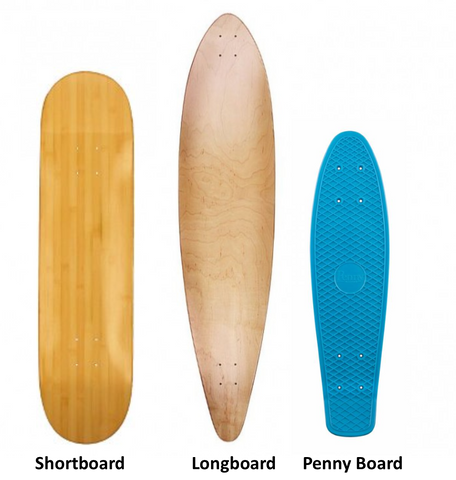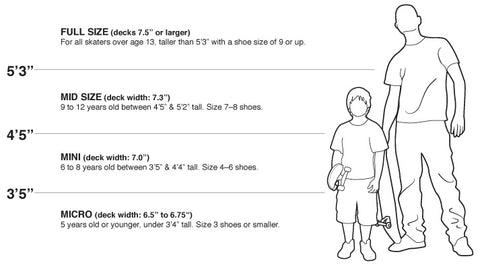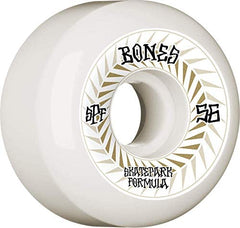How To Choose A Skateboard

Imagine this: your kid (or grandkid) looks deep into your eyes, clasps their hands over their heart, and tells you—all they want for their birthday is a skateboard.
Awesome! Exciting times ahead.
Except...you’ve never skateboarded. (Or if you did, it’s been a while.) And you have no idea which kind of skateboard to buy for them. How big? What kind? A longboard?
It can be overwhelming—which is why we put together this handy guide to take you through the process of choosing a skateboard, step by step.
Part 1: Picking the right type of Skateboard
Step 1: Find the right skateboard size
The first and most important question in choosing a skateboard—what will the skateboard be used for? Just like you wouldn’t buy a cello for someone who wants to play music in their tiny apartment (a ukulele is probably a better match) or a pack of frozen dinners for a budding chef (maybe splash out on a KitchenAid), you want to make sure this board fits the function.
Is the prospective skater just interested in getting to school or friends’ houses without needing to stash a bike somewhere? Or do they want to learn some sweet tricks?
Skateboards come in all different sizes but there are 3 main classes. In order from smallest to largest, there are penny boards, skateboards (also called short boards), and longboards.
Generally, Penny boards are around 20 - 24" long. Skateboards are around 28 - 30" long on average. And longboards are, of course, longer. Longboards average anywhere from 32" to 40" and above.
Now there are also some classes within these generalizations but for now, this broad categorization is fine.
Ask yourself, what do you think you'll be doing on the skateboard?
Just going around the neighborhood? If the board is just for transportation, they’ll want a longboard or a pennyboard.
Going to the skatepark? If they want to do tricks, you’re looking at a traditional skateboard—a shortboard.

OUR FIRST BOARD RECOMMENDATION: The Krown Rookie Skateboard Complete
Made out of Canadian maple with sturdy aluminium trucks, this is the perfect skateboard for beginners. Krown is an American-made brand and a notch above any skateboard from Walmart or Target.
Step 2: Pick the right board shape
You might think all boards are flat, but you’ll soon discover there are a ton of options to choose from. Radial, progressive, w-concave, flat-cave, asymmetric, convex...all of these are helpful for experienced skaters who want to perform certain tricks better, but for first boards, they’re not super helpful.
A radial concave shape is what most skateboards will have. In this configuration, the edges of the skateboard will be slightly higher than the center. This helps center your feet and keep your feet on the skateboard.
For your first skateboard, don't worry about the shape! The main thing you should be worried about is just making sure it's comfortable to stand on. Learning to skateboard takes a while and (duh!) you'll be standing on your skateboard for a while.
OUR FIRST BOARD RECOMMENDATION: The Krown Rookie Skateboard Complete
Made out of Canadian maple with sturdy aluminium trucks, this is the perfect skateboard for beginners. Krown is an American-made brand and a notch above any skateboard from Walmart or Target
Step 3: What size skateboard do I need?
There are four main sizes of skateboards decks, all measured by the width of the board: micro, mini, mid size, and full size.
Micro boards are 6.5 – 6.75 inches wide and are for kids 5 and under.
Mini boards are 7” wide and are ideal for slightly older kids.
Our Pick for Best Mini Board: The Meketec 22" Inch Mini Cruiser
With it's short size, it's the perfect introduction to skating for young boys and girls. For best results, add Board Blazers to it so it'll light up at night!
The most common beginning deck size for kids is mid-size, which correspond to shoe sizes 7 and 8.
Beginning adults will want a full size board, which are 7.5” or wider. This handy chart from Warehouse Skateboards does a great job explaining the differences:

Step 4: Choose a material
In the construction of skateboard decks, Canadian Maple is the most common material. The two other most popular board-making materials are Bamboo and Baltic Birch plywood.
Plastic is another alternative that is much cheaper, and is usually found in penny boards. There are also aluminum and fiberglass decks that work in a similar way.
Canadian Maple’s popularity comes largely from the quality of the wood and stability it provides.
OUR FIRST BOARD RECOMMENDATION: The Krown Rookie Skateboard Complete
Made out of Canadian maple with sturdy aluminium trucks, this is the perfect skateboard for beginners. Krown is an American-made brand and a notch above any skateboard from Walmart or Target
Step 5: Decide on COMPLETE vs BUILD YOUR OWN
Yes, you CAN build your own skateboard by purchasing the deck, wheels, trucks, and bearings separately, and then assembling it on your own.
In the rare case that your prospective skater knows exactly what they want (i.e. wheel size/material, custom deck shape, etc.), steer away from those murky waters—ESPECIALLY for a first board.
Instead, go for a “complete.” That means a pre-assembled skateboard that includes all components.
Once your prospective skater has developed some skating preferences, you can always upgrade piece-by-piece.
Part 2: Buying The Board
Step 6: Decide where to buy
The safest way to make the best choice, especially if buying a board for your child, is to visit a local shop. Yes, you can buy skateboards (and literally everything else) online, but it’s difficult to get a feel for a board’s physicality when all you see is some pictures.
If you visit a local skate shop, you’re getting the benefit of their expertise. Plus, some shops even allow customers to take boards for a short test ride—and you get to support the local economy!
Quick note: Try to avoid Walmart or Target for your first skateboard. They get away with selling very cheap and (kinda crappy) boards all the time. If you want an easy place to shop online, I'd recommend Amazon.
As an extra bonus, you can ask the salesperson about local places to skate, and if you’re spending more than $50 on a new board, you can also ask for some free extras like skate stickers or skate wax.
Step 6: Inspect the quality of the board
On a good quality board, the wheels will roll more easily, it will be easier to turn (that’s a good thing!), and it’ll be more stable than cheaper boards.
Before you pull out your wallet, check out the board’s quality. As an easy rule of thumb, you’re checking for the amount of plastic. More plastic = bad.
Here’s what you’re looking for:
- The trucks connect the wheels to the deck. If the trucks are plastic, that’s a BAD sign. Trucks should always be some sort of metal - aluminum is the most common material for beginner skateboard trucks. Want to learn more? Check out our article about low and high trucks here!

- Pass on plastic or rubber wheels. Wheels should be made of urethane (often a whitish clear color like below), which provide a smoother ride and better grip. Ask a salesman if you’re not sure.

- Spin the wheels. Do they spin freely, without any grinding or wobbling? ABEC is a scale of the preciseness of a bearing. You want at least ABEC 5 or 7 for skating.
Step 7: Expect the right price
Warning: Don’t cheap out.
In general, here’s what you can expect to pay for a complete skateboard at a skate shop:
Shortboard: $39.99 - $69.99
Our Recommendation: The Krown Rookie Skateboard Complete
Made out of Canadian maple with sturdy aluminium trucks, this is the perfect skateboard for beginners. Krown is an American-made brand and a notch above any skateboard from Walmart or Target
Longboard: $59.99 - $99.99
Our Recommendation: The Quest Super Cruiser 44"
Perfect for beginners, this longboard will glide across the pavement and make it feel like you're surfing on land. Made out of multi-hardwood, the deck feels firm and steady underneath your feet.
Penny Board/Plastic Cruiser: $59.99 - $99.99
Our Recommendation: The Rimable 22" Skateboard
Short yet with a eye-catching design, this is the perfect short board to get started with. At half the price of an official Penny Board, this shortboard doesn't break the wallet either.
Seem like more than you wanted to spend? There are cheaper options of course but see above with regards quality and safety. Most skateboards under $30 won't last more than a month or 2.
Conclusion
We know giving a skateboard as a present can be overwhelming, especially if you’re not super familiar with the sport. But if you carefully follow these seven steps, you’ll have a perfect gift in no time!
If you have any questions about your specific skateboard-buying situation, please email us at david@boardblazers.com—seriously! We’re not joking. Send us an email and we’ll do whatever we can to help you out.
Note: This is a revamped version of an article originally written by Yogin Patel. To read some of Yogin's other articles, check out 7 Benefits of Skateboarding or Top 5 Summer Skateboarding Camps in the United States.
Photo credit: Max Garcia
